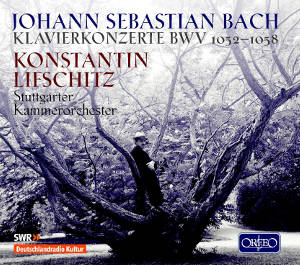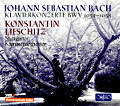ORFEO International – Catalogue
CDs
 | Johann Sebastian Bach
Klavierkonzerte BWV 1052-1058Orfeo • 2 CD • 1h 49min Order No.: C 828 112 A |
|
Composers/Works: |
J.S. Bach: Piano Concerto No. 1 d minor BWV 1052 for Piano and Orchestra
J.S. Bach: Cembalo Concerto No. 2 E major BWV 1053
J.S. Bach: Piano Concerto No. 3 D major BWV 1054 for Harpsichord, Strings and basso continuo
J.S. Bach: Harpsichord Concerto No. 4 A major BWV 1055 for Piano and Orchestra
J.S. Bach: KlavierConcerto No. 5 F major BWV 1056 for Piano and Orchestra
J.S. Bach: Harpsichord Concerto No. 6 F major BWV 1057 (KlavierConcerto)
J.S. Bach: Harpsichord Concerto No. 7 g minor BWV 1058
|
Artists: |
Konstantin Lifschitz (Klavier)
Stuttgarter Kammerorchester (Orchester)
|
Johann Sebastian Bach - Klavierkonzerte BWV 1052-1058
Konstantin Lifschitz has long since established himself as an outstanding exponent of the works of Johann Sebastian Bach. He has already recorded the Musical Offering BWV 1079 and the Art of Fugue BWV 1080 for Orfeo and has now turned his attention to the composer’s seven keyboard concertos BWV 1052–8, in which he is partnered by the Stuttgart Chamber Orchestra, an ensemble that enjoys an equally distinguished reputation for its Bach interpretations. 
C 828 112 AAnd yet these works require music-making of a completely different order from the sort that we would expect to find in the Brandenburg Concertos, 
Konstantin Lifschitz
Foto: Felix Broedefor example, for the sources, genesis and transmission of these keyboard concertos in the form of transcriptions of earlier pieces raise more questions than they answer. With only three of these seven concertos has it been possible to identify specific originals with different solo instruments, while the other four have been ascribed to various other instruments by experts in the field, attributions that none the less continue to be hotly debated. The fact that Konstantin Lifschitz admits to “feeling now as a harpsichord, now as a piano, now as an oboe d’amore and now as a violin” may increase the demands on the performer, but it also enhances their appeal for their audiences, for Lifschitz has at his command exactly the sort of touch and playful cunning needed to free the piano from its function as a continuo instrument and turn the whole experience into something intensely vital. And the fact that he plays these works on a modern concert grand is wholly convincing, not least because in Bach’s day instruments were evolving all the time and Bach himself was fond of experimentation in this as in so many other areas. Although there is no denying the impulses that he received from Vivaldi and other Italian contemporaries, his quasi-cantabile phrasing and part-writing in these concertos anticipate some of the features that make Mozart’s concertos so special. The cyclical overview provided by Konstantin Lifschitz and the Stuttgart Chamber Orchestra in the case of the present recordings allows us to appreciate the old and the new in a clear and compelling way.
|